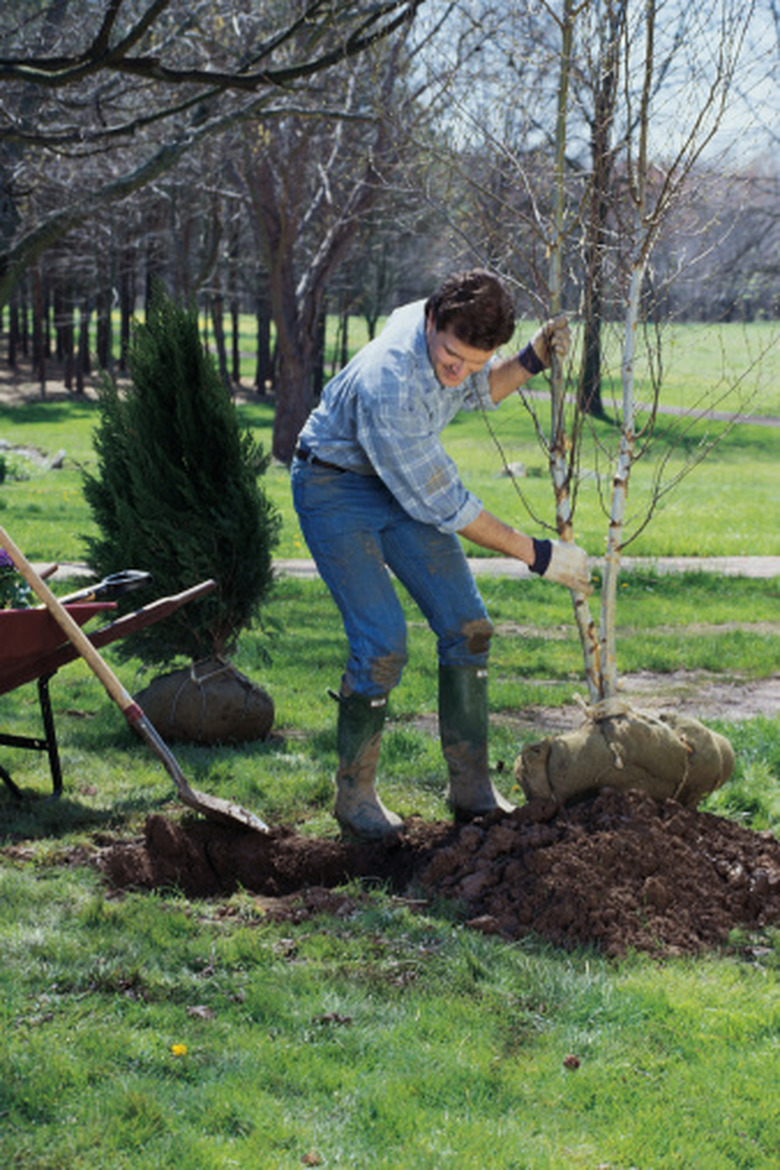How Long Should You Stake A Young Tree?
Planting trees or palms from containers or as dug-up balled plants allows you to purchase larger specimens for immediate visual effect in the garden. The downside of planting larger trees is the lack of sprawling root system to hold up the tall or top-heavy plant. To stabilize a newly planted tree or palm, you can stake it to diminish excessive movement in winds. Keep the support system in place for six to 12 months.
Staking Insight
If a newly planted tree or palm is less than 5 feet tall, staking most likely isn't needed. The slender trunk and lack of many leaves doesn't catch much wind and lead to leaning or toppling. When staking taller trees in exposed sites where winds abound or people may lean or walk nearby, use wooden or metal stakes or a three-part guy wire configuration. Don't tie the tree tightly against the support. Some wiggle movement helps the tree roots develop more extensively to stabilize the entire tree. Orient stakes where they're not a tripping hazard and prevailing winds don't push and rub the tree trunk into the supports.
- Planting trees or palms from containers or as dug-up balled plants allows you to purchase larger specimens for immediate visual effect in the garden.
- To stabilize a newly planted tree or palm, you can stake it to diminish excessive movement in winds.
Young Trees
When planting young trees or tall saplings, chances are the plant isn't much taller than 5 to 8 feet. In exposed sites where winds bombard the young tree, staking ensures it remains relatively upright and the root ball doesn't rock and tear as the new roots grow outward. For small-sized young trees, stake them for one growing season, or about six months. Remove the ties or guy wire supports so that they do not constrict branches or trunks and restrict growth and flow of sap. If after six months the tree is overly flimsy, or the soil is lightweight and porous, keep the support on for up to one year. If a tree is still poorly rooted after one year, other concerns exist, such as a damaged or partially dead or malformed root system.
Palm Staking
Palms are not real trees since they lack cambium and bark. However, their large trunks and wind-catching fronds warrant staking, especially if the trunk is taller than 6 feet. Palms are supported with wooden stakes that are strapped onto the trunk, not nailed. Palms do not heal nail wounds so do not secure supports on palms by driving nails or screws. Keep supports on palms for six to eight months, but up to one year, especially if the palm is enduring its first tropical storm season.
- When planting young trees or tall saplings, chances are the plant isn't much taller than 5 to 8 feet.
- In exposed sites where winds bombard the young tree, staking ensures it remains relatively upright and the root ball doesn't rock and tear as the new roots grow outward.
Monitoring Staked Plants
Take the time to check on staked trees and palms every month. If a windstorm occurs, check the supports and the condition of the plant trunk for injury or issues. Adjust the supports to alleviate rubbing as necessary. After six months, look at the trunk surface where the support cables, ties or wires contact. Slightly loosen the tension so the trunk bark is not denting as a result of the pressure. Move and re-tie ties in a different location before the tree bark is starting to enclose or envelope the ties into the outer bark tissues.
References
- Kansas Forest Service; Staking and Guying Landscaping Trees; Kim Bomberger; 2005
- "Your Florida Landscape"; Robert J. Black and Kathleen C. Ruppert, eds.; 1998
